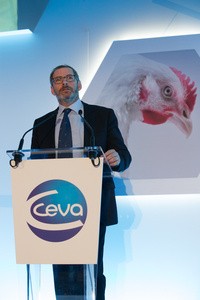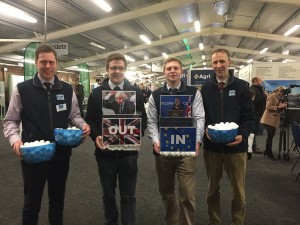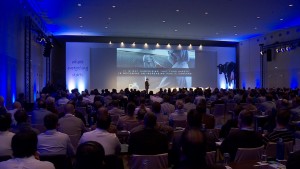Our Videos Hit The Social Media Agenda
/0 Comments/in News /by Nik WoodOur involvement in a major ‘summit’ in Barcelona saw widespread coverage of our video material on social media outlets including Facebook, Linked In, Twitter and, of course You Tube.
See the video clip announcing the social media outlets by clicking here.
We also provided the live hosting for the final day of the third Ceva poultry Vaccinology Summit at the prestigious W Hotel on Barcelona’s waterfront, before an audience of 400 vets, customers and key opinion leaders. Within minutes of the event starting, Ceva’s communications team was Tweeting JPEGs and text and our video interviews with several world leading experts that we created on the spot with our lightweight mobile edit equipment, quickly began appearing on the social media networks.
Ceva’s social media team are now used to regularly embedding videos into the Ceva Facebook site itself while also uploading to the overview You Tube channel. Using our background in business broadcast journalism we are able to record videos, edit within minutes and also write supporting text and make the whole thing live while the event is continuing in the background.
Later in the convention we were able to add another dimension when we provided the facilitator for a major live debate involving six of the key opinion leaders and Ceva personnel on the stage at the summit which involved many questions from the capacity audience.
The Summit was called against the backdrop of the fact that for over eighty years antibiotics have protected both the health of animals and humans. Protecting their future, through more targeted use has become one of the most pressing issues for Governments, Health Authorities, veterinarians and poultry producers. “Antibiotic free” poultry production brings with it many challenges and potential welfare issues. As consumers demand healthier food, can this be delivered, whilst ensuring that birds that fall sick are properly treated?
Poultry producers currently face many challenges to adjust their production systems. One of the most critical of the required changes is achieving better management of individual bird and flock health status. Since the emergence of the first very virulent respiratory diseases in poultry in the late 1950’s, the global industry has fought a constant battle to protect flocks against disease through biosecurity and vaccination programmes.
Vaccination was considered to be effective if it prevented or reduced clinical symptoms in affected flocks. However, widespread use of new technology vaccines such as Transmune™, Vectormune ND™ and Vectormune AI™, which are associated with improved hatchery application, provide more than just disease protection, by reducing disease occurrence and therefore the probability that birds will fall sick.
Dr Sylvain Comte said: “On farm trials and associated work from scientists and poultry producers has shown that consistent, correct application of new technology vaccines allows producers to both control and reduce disease burden for both present and future flocks. This reduces the risk of clinical or subclinical sickness and therefore the likelihood that birds will need to be treated with antibiotics.”
Ceva’s commitment to responsible antibiotic use is evidenced in programmes that focus on protection as well as reduction of disease spreading. Dr Sylvain Comte continues, “This innovative approach aims to ensure that poultry farms are healthier and less exposed to bacterial infections, fulfilling the joint needs of the consumer and the poultry producers. Ceva will continue to contribute to improved bird health status and help the industry to face the new challenges of antibiotic free production.”
EU – Farming, In or Out?
/0 Comments/in News /by Nik WoodThe EU debate that we hosted and filmed at Agri Expo 2016 in Kent on behalf of land and property experts BTF Partnership, was a prime example of how Good Call Media really differentiates itself from its competitors.
See the video of the event by clicking here.
We were brought in by Coast Communications a leading UK public relations consultancy, acting on behalf of BTF, and asked to run a debate in the Kent County Showgrounds, during the Agri Expo event which asked the question: ‘Will farmers and landowners be better off in or out of the EU?’. Coast Communications also wanted the event filming for use on BTF’s website and social media outlets.
Our own Nik Wood went on stage to host the event and act as Master of Ceremonies and, although we expected a great deal of interest, even we weren’t prepared for the number of people who packed into the auditorium where there was standing room only.
Within minutes of the event ending, we had edited video highlights from the debate and this was made available for use on the BTF website and to other participants – a perfect case study of our ability to make live events really work and capture high quality video as part of the project.
Global Launch Success
/0 Comments/in News /by Nik WoodOur work for our major client, Ceva Santé Animale, saw us supporting the world wide launch of a breakthrough product in the ruminant or dairy cattle arena, Velactis® (see video report here)
Ceva Santé Animale is a global veterinary health company focused on the research, development, production and marketing of pharmaceutical products and vaccines for pets, livestock, swine and poultry and the launch of Velactis®, in Barcelona, was a major event. Good Call Media was in Barcelona to film key elements of the symposium and to interview key opinion leaders, including world class veterinary experts.
These videos were then broadcast through social media channels including Facebook, Twitter and Linked In.
Velactis® is the first and only injectable dry-off facilitator for dairy cattle. A single injection facilitates the abrupt dry-off procedure by allowing rapid cessation of milk production in the udder, preventing it from becoming painfully engorged and leaking milk, which can increase the risk of new intramammary infections that can lead to mastitis.
More than 350 vets from 40 countries attended the global launch.
Speaking at the launch, Lorraine Sordillo, Professor of Large Animal Clinical Sciences at Michigan State University, said: “We’ve been struggling with this issue for decades; farmers want to maximise the amount of milk they get from cows, but the problem is to get them to stop producing at dry-off. The innovation of dry-off facilitators has been needed since we started milking cows, because we know that the amount of milk being produced a dry-off is directly related to the cow’s ability to optimise milk in the next lactation as well as optimising her immune system.”
Interesting links
Here are some interesting links for you! Enjoy your stay :)Categories
Archive
- March 2024
- February 2024
- January 2024
- December 2023
- November 2023
- July 2023
- June 2023
- May 2023
- April 2023
- March 2023
- September 2022
- June 2022
- May 2022
- April 2022
- January 2022
- December 2021
- November 2021
- October 2021
- March 2021
- December 2020
- November 2020
- September 2020
- August 2020
- March 2020
- January 2020
- December 2019
- November 2019
- August 2019
- July 2019
- June 2019
- May 2019
- February 2019
- January 2019
- November 2018
- October 2018
- September 2018
- July 2018
- June 2018
- May 2018
- April 2018
- March 2018
- February 2018
- January 2018
- December 2017
- November 2017
- October 2017
- September 2017
- August 2017
- July 2017
- June 2017
- May 2017
- April 2017
- March 2017
- February 2017
- January 2017
- December 2016
- October 2016
- September 2016
- July 2016
- May 2016
- April 2016
- March 2016
- January 2016
- December 2015
- November 2015
- October 2015






